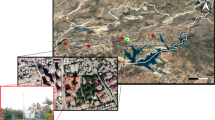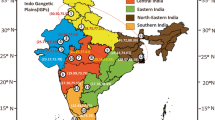Abstract
Ozone formation from a propene-nitrogen oxide-wet air mixture was modeled and simulated by using a detailed reaction model to characterize ozone formation in air pollution. Effects of reaction parameters such as light intensity, initial concentrations of propene and nitrogen oxides, temperature and humidity were investigated. The loss reactions of N2O5 by H2O were incorporated in the model developed in the present study. Results of simulations showed good agreement with smog-chamber experimental data. From the results of simulations it was found that the maximum ozone concentration was little affected by humidity. The model proposed in the present study can be used to predict the amount of ozone formation successfully.
Similar content being viewed by others
References
Carter, W. P. L., Lloyd, A. G, Sprung, J. L and Pitts, J. N. Jr., “An Experimental Investigation of Chamber-Dependent Radical Sources”,Int. J. Chenu Kinet.,11, 45 (1979a).
Carter, W. P. L., Winer, A. M., Damai, K. R. and Pitts, J. N. Jr., “Smog Chamber Studies of Temperature Effects in Photochemical Smog”,Environ. Sci. Technol.,13, 1094 (1979b).
Fan, Z., Kamens, R. M., Zhang, J. and Hu, J., “Ozone-Nitrogen Dioxide-NPAH Heterogeneous Soot Particle Reactions and Modeling NPAH in the Atmosphere”,Environ. Sci. Technol.,30, 2821 (1996).
Graham, R. A. and Johnston, H. S., “The Photochemistry of NO3 and the Kinetics of the N2O5-O3 System”,J. Phys. Chem.,82, 254 (1978).
McRae, G. J., “A Simple Procedure for Calculating Atmospheric Water Vapor Concentration”,J. Air Pollution Control Assoc.,30, 394 (1980).
Sakamaki, F., Okuda, M., Akimoto, H. and Yamazaki, H., “Computer Modeling Study of Photochemical Ozone Formation in the Propene-Nitrogen Oxides-Dry Air System. Generalized Maximum Ozone Isopleth”,Environ. Sci. Technol.,16, 45 (1982).
Seinfeld, J. H., “Atmospheric Chemistry and Physics of Air Pollution”, John Wiley & Sons, New York (1986).
Stockwell, W. R. and Calvert, J. G., “The Near Ultraviolet Absorption Spectrum of Gaseous HONO and N2O3”,J. Photochem.,8, 193 (1978).
Weaver, J., Meagher, J. and Heicklen, J., “Photooxidation of CH3CHO Vapor at 3130 A”,J. Photochem.,6, 111 (1977).
Whitten, G. Z., Killus, J. P. and Hogo, H., “Modeling of Simulated Photochemical Smog with Kinetics Mechanisms”, Final Report, EPA-600/3-80-028a,1 (1980).
Author information
Authors and Affiliations
Corresponding author
Rights and permissions
About this article
Cite this article
Oh, S.C., Yeo, YK. Modeling and simulation of ozone formation from a propene-nitrogen oxide-wet air mixture in a smog-chamber. Korean J. Chem. Eng. 15, 20–27 (1998). https://doi.org/10.1007/BF02705301
Received:
Accepted:
Issue Date:
DOI: https://doi.org/10.1007/BF02705301




